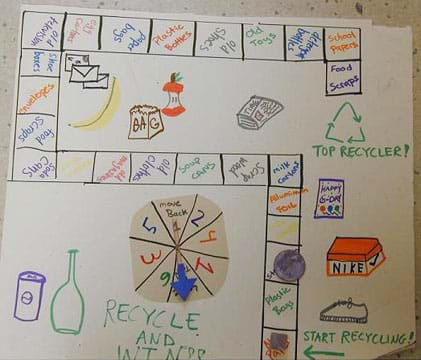Design a Recycling Game
Activity courtesy of TeachEngineering, a digital curriculum library created by the University of Colorado Boulder’s College of Engineering. It is part of an upper-elementary environmental engineering unit called Reduce, Reuse, Recycle, and Compost developed at Worcester Polytechnic Institute.
Summary
Students brainstorm ideas for board game formats. They then work in teams to design, create, and test games in which players must think of alternative uses (recycling) for used products.
Grade level: 3-5
Time: 1 hour 15 minutes (two 40-minute classes, one to design the game, the other for playing it and discussion)
Engineering connection
Environmental engineers are continually designing new ways to care for our environment and improve recycling techniques. Recycling is a great way to reuse items so that less waste is put into landfills and is important for materials that are difficult or costly to obtain.
Learning objectives
After doing this activity, students should be able to:
- Think creatively to reduce waste products
- Understand and apply board game design techniques
- Work cooperatively in a group
Learning standards
Next Generation Science Standards
- 3-5-ETS1-1. Define a simple design problem that reflects a need or want, can be solved through the development of an object, tool, process, or system, and includes specified criteria for success and constraints on materials, time, or cost.
International Technology and Engineering Educators Association
- Waste must be appropriately recycled or disposed of to prevent unnecessary harm to the environment.
- Identify and collect information about everyday problems that can be solved by technology, and generate ideas and requirements for solving a problem.
- Investigate and assess the influence of a specific technology on the individual, family, community, and environment.
- Compare how things found in nature differ from things that are human-made, noting differences and similarities in how they are produced and used.
Materials
- poster board or, alternatively, the back side of a used poster board
- markers
- spinner; alternatively, make out of cardboard square, paper arrow, and a thumb tack
- (optional) dice
- game pieces; alternatively, make them out of bottle caps
- tacks
- construction paper; alternatively, colorful magazine pages
- ruler
Introduction/Motivation
Earth is running out of space in its landfills and our nonrenewable resources are being depleted! How can we reuse some of our “garbage” so that we throw away less?
Procedure
Background
Natural resources are the materials in our environment that are used to make products (for example, wood from trees to make paper).
Non-renewable resources are those materials that cannot be replaced by natural ecological cycles or sound management procedures (for example, oil, plastics).
Recycling is using a product more than once so that natural resources can be saved and so that we won’t need so many garbage dumps and landfills. There are different ways to recycle. One way is to find a different use for a product. For example, we can use empty cans as pencil holders. Another way to recycle is to use heat, chemicals, bacteria or pressure to break a product down into its basic materials, and then reform these materials into a similar or different product.
Preparation
- Gather materials.
- (optional) Make a game to show students as an example
(see photo of example game: “Recycle and Win!” copyright 2004 Tufts University Center for Engineering Education and Outreach)

With the students
- Introduce the Topic: Discuss recycling and different objects that are recycled. Brainstorm ideas for recycled materials. Some examples are plastic/foam cups, old tires, old clothes, egg carton, cardboard tubes, milk cartons, milk jugs, paper bags, baby food jars, shoe boxes, bottle caps, jar lids, etc.
- Group students and have them come up with as many different board games as they can. Once they have created lists, have groups sort their lists into categories such as dice, spinner or cards. On the board, document all of the different types of games that the students thought of.
- Optional: Demonstrate a game that the teacher made in advance. An example game format might be a spinner board game. On their turns, students spin the spinner, which is labeled with numbers, and move the indicated number of spaces. Each space is labeled with a used product. As the students land on the spaces, they must think of an alternative use for the product or go back to their previous space. The first to reach the end wins.
- Activity: Divide the class into teams of three or four students each.
- Have each group develop a list of ideas for materials that can be recycled and reused.
- Have each group design and build a board game. The games may be any type of game as long as they incorporate the idea of finding alternative uses for the materials that they listed. The games must include instructions.
- After each team has designed and built their game have the class switch games between groups and play another team’s game.
Investigating questions
- What different uses for used materials could you think of?
- How can used products be reused?
- Why do we need to recycle?
- Which board game did you like the most? Why?
- What game did you find the most challenging? Why?
Assessment
Rubric for recycling game performance assessment [PDF] or [Doc]
References
Kessler, James H. and Andrea Bennett. The Best of WonderScience: Elementary Science Activities. Boston: Delmar Publishers. 1997. ISBN: 0827380941 pg. 220, 222.
Filed under: Class Activities, Grades K-5, Lesson Plans
Tags: Class Activities, Curriculum, Engineering Design, Environmental Engineering, game, Grades K-5, Lesson Plan, Recycling, systainability








